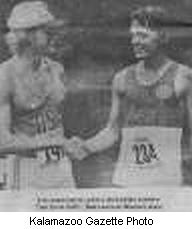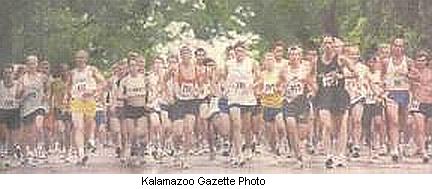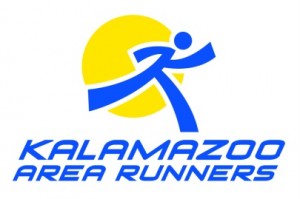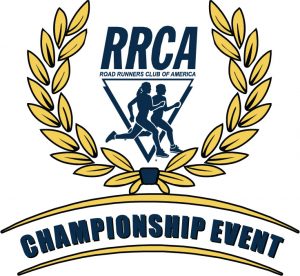A 45 -YEAR TRADITION
When the gun sounded for the first Kalamazoo Klassic at precisely 8:57 a.m. on June 30, 1979, 650 runners sprinted off on a 10-kilometer course of what is now the oldest running event in Kalamazoo.

Twenty-five years later, on June 21, 2003, hundreds of runners celebrated a quarter century of success by gathering yet again for competition and personal pleasure on the top of Maple Street hill for another sounding of the classic Klassic gun. Many things have remained unchanged since 1979: Maple Street Hill, all-volunteer sponsorship by the local running club, and the excitement of the field. But many things have changed: the addition of the 5K run, electronic timing (the “chip”), the finish in South Middle School Fields, and the increasing number of women and older runners.
The Beginnings
In the late 70’s the Kalamazoo Track Club was a collection of about 25 serious runners whose focus was training and racing competitively. At the same time the running boom for the average person was sweeping the nation in the wake of Frank Shorter’s Olympic Marathon win in 1976 and the popularity of Jim Fixx’s best-selling book “The Complete Runner.” Joggers were everywhere. With this backdrop, a few members of the Track Club, with Blaine Lam as their spokesperson, proposed that the club pursue a new direction: “Embrace the average runner.” The critical vote on the new direction was 13 to 12 in favor of the change and the stage was set for the birth of the Kalamazoo Klassic.
The renovated club, with David Kays as President and Blaine Lam as Vice President/Newsletter editor, captured the local running community with its calendar of regular races, an informative newsletter, and the idea of sponsoring a major road race to be called the Kalamazoo Klassic. The first race was run “on a shoestring,” Lam says. “There was minimal sponsorship (Lee’s Sports was the main sponsor) and the scoring was done with 3×5 cards.”
The front page of the Saturday Kalamazoo Gazette bore a large picture of the start with the caption:
the start with the caption:
“Road Runners a Hardy Breed as They Compete in Rain Today in First Kalamazoo Klassic.”
That Gazette also contained a picture of President Jimmy Carter running (not in Kalamazoo) and an article on the retirement of Mohammed Ali.
The 1979 Klassic resulted in a tie between WMU teammates Tom Duits and Bob Lewis in 30:58. Tom Duits is known as the first Michigander to run a sub 4:00 mile and still holds the mile record at WMU.
The 80s
In May 1980 a tornado ravaged downtown Kalamazoo, killing five people and causing millions of dollars in damage. The second Klassic was run a little more than a month later as Kalamazoo recovered from this blow of nature. The race date was moved to June 14, with the field capped at 1000 – and easily filled. First National Bank signed on as a major sponsor, a role that it played for many years. The year 1980 was also the debut of the turtle, a graphic T-shirt mascot that appeared off and on in different forms for most of the years of the Klassic. The front page of the Saturday Gazette had three pictures of the Klassic and described the day as “threatening sky and rolling thunder.” But as we know, that doesn’t deter runners.
The third Klassic (1981) grew to 1,323 participants and witnessed the return of the winners of the first Klassic. Duits and Lewis repeated their feat by finishing together in a time of 30:19. The women’s race was won by WMU’s Darcy Tomlinson in a very fast 35:27. Kalamazoo has always been the home of excellent Masters runners as shown by the finishes of Randy Hoffman (33:05) and Tina Hayward (39:20). Tina would go on to win the Boston Marathon Masters a few years later. The 1981 race was held on the 3rd Saturday of the month, setting a tradition followed since.
Many dedicated KTC members nurtured the race in these early years. Blaine Lam was consistently a driving force. Tom Powell, James and Linda Gregart, and Dave Mackey were heavily involved in the growth of the race. The fields were generally over 1,000, with hundreds of finishers under 40 minutes. In 1983 a 40:00 time would not have broken into the top 200 places.
The race has not been without its tragedies. In 1982, Richard Robbins, 49, collapsed 200 yards from the finish line as he was ascending Peeler Hill. Within seconds he was being treated by paramedics, but died a few days later.
When two local runners, Chris Crowell and Bruce Johnson, formed Gazelle Sports, they began a long and continuing relationship with the Klassic. In 1988 Gazelle Sports started their sponsorship of the Kids’ Klassic, a 1K Kids’ run on the evening before the 10K (which had been started by the KTC about 4 years earlier.) Hundreds of kids and parents line up every year for this fun family event. Several of the top runners in high school the last few years had their first experience running at the Kid’s Klassic including Adriana Field and Jessie Stewart who both now run for the University of Michigan.
In 1985 the 5K race was added. Five-K races were gaining in popularity and the new distance was added to attract joggers who were not yet ready to tackle Maple Street Hill, better known as Kalamazoo’s ‘Heart Break Hill.’
In 1987 the finish was moved from the top of Peeler Street to the fields at South Junior High. The move allowed more room for spectators and post race activities.
The 90s
In 1996 and in 1997 the 10K event was eliminated. Entries for the longer race had been decreasing and expenses to stage the race had been increasing. For 2 years the 5K was the only event.
On the eve of the 1997 Klassic a ferocious storm swept through southwest Michigan. Many trees were down, many homes were without power, and many events in the region were cancelled… except, of course, the Klassic, which went off without a hitch in humid weather.

In 1998 the 10K was reinstated by popular demand for the 20th Anniversary of the Klassic. Although the 10K still does not have as many participants as the 5K, it remains the essence of the ‘Klassic.’ This was also the first year the “chip” (a device the size of a quarter that is laced onto the shoe) was used to facilitate timing.
2000 and Beyond
In 2000 KTC began its partnership with MRC Industries in sponsoring the race. MRC excels in gaining sponsorship and providing organizational skills and the Kalamazoo Area Runners – the Kalamazoo Track Club’s new name as of 2002 – provide the expertise in race management.
In 2008, The Kalamazoo Klassic proudly celebrated its 30th anniversary and in 2018, celebrated its 40th anniversary.
In 2020, the 42nd annual Kalamazoo Klassic was organized as a virtual race due to the COVID-19 global pandemic. In 2021, although the race was scheduled as an in-person event, a line of severe thunderstorms moved through the area just as the 10k was scheduled to start. The storms required the event to be cancelled and all runners moved to a virtual race. The pandemic also marked the end of the Kids’ Klassic event, which was last held in 2019.
The Kalamazoo Klassic remains in good health as we emerge from the pandemic and move closer to the half century mark.
Acknowlegements
Several participants have made the Klassic a part of their lives for 25 years. Dick Hoeskstra ran the first Klassic in 1979 as a high schooler. Since then Dick has finished all 23 Klassic 10Ks and the 5K for the two years the 10K was not offered. Dave Dunn has also participated in all 25 races. Dave ran the 1979 race as a high schooler and continued to race the Klassic during his years at WMU where he ran track. His best time at the Klassic was 32:18 in 1984. A chronic back injury ended his running career in 1993 but he returned as a Race Walker and has won the Klassic 5K Walk three times. Patsy Hand was talked into running the first Klassic by a friend. Since then she has participated every year despite forgotten numbers and torn ligaments. Patsy, Dave and Dick were presented 25 Year Commemorative Jackets at the 25th Klassic Race Awards Ceremony.
Bob Rafferty has been a volunteer for all years the event took place in person and he has all race t-shirts.
The YMCA has also been involved all years through 2019. They have provided their facilities for race planning meetings, late registration, and packet pick-up.
Where are they now?
David Kays (1979 Track Club President and first Race Director) lives near Nashville, Tennessee. He no longer runs but swims and bikes. James Gregart (Fired the starting gun at the first Klassic) is Kalamazoo County Prosecutor. Bill Krasean (Involved in race organization) is still at the Kalamazoo Gazette and active in the local running community. Blaine Lam (Race Director for several years and a catalyst for Club activity in the 80s) is a Independent Consultant in Kalamazoo and is active in the Borgess Run organization.
Acknowledgements
The author thanks Blaine Lam and Bill Krasean for contributions to this article. Please direct correspondence regarding this article to Jay Campbell. History added by Bonnie Sexton for 2008 and beyond.






